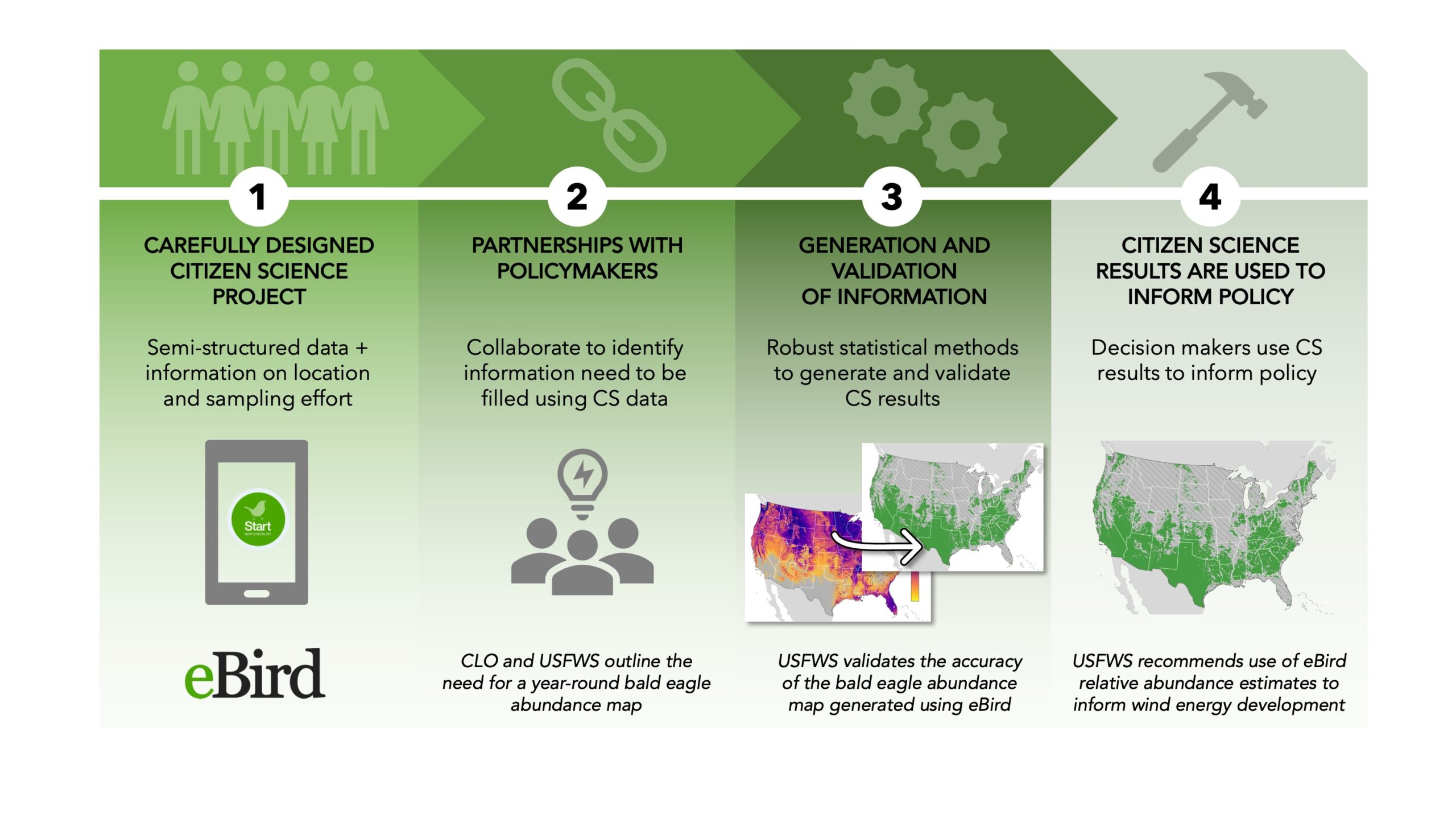Public participation in scientific research through citizen-science projects has skyrocketed in the past 10 years. Citizen scientists have been donating billions of dollars’ worth of their time collecting information on everything from birds, bees, butterflies, and more resulting in a treasure trove of data helping scientists better understand plant, animal, and insect populations.
New research out this week in the Journal of Applied Ecology finds that citizen-science data not only can help us better understand wildlife populations it can also be used to inform policies designed to safeguard birds.
The U.S. Fish and Wildlife Service sought to refine its process for identifying places where wind energy projects can be sited with minimal risk to Bald Eagles. “It was important to account for eagle use throughout the entire year in order to have confidence that activities in a low-exposure zone would pose less risk to eagles overall,” says Emily Bjerre, wildlife biologist at the National Raptor Program at the U.S. Fish and Wildlife Service. That’s when the U.S. Fish and Wildlife Service turned to eBird, one of the world’s largest citizen-science efforts at the Cornell Lab of Ornithology.
When it comes to informing policy decisions, one key aspect is knowing that the data being used to support the policy are valid and reliable. The team, including scientists at the U.S. Fish and Wildlife Service and the Cornell Lab of Ornithology rigorously compared five different data sources, including the Christmas Bird Count, the Breeding Bird Survey, citizen-science data from eBird, and surveys conducted by the Fish and Wildlife Service. They found that the sightings submitted by eBirders and the advanced statistical models generated by the eBird Status and Trends Project Team provided the best available, high-resolution information across wide areas of the United States for the entire year—a key piece needed to advise wind-energy policy.
“Compared to other data sources, eBird gave us the best opportunity to define low-exposure zones at a refined spatial scale,” says Bjerre. “The ‘wall-to-wall’ coverage provided by eBird was critically important,” says Brian Millsap, national raptor coordinator at the U.S. Fish and Wildlife Service. “The other data or surveys we evaluated generally cover a specific ‘season’—for example, winter or breeding,” says Millsap, “but then you don’t have any information of what eagle abundance in that area is the rest of the year.”The other key piece, says Viviana Ruiz Gutierrez, assistant director of the Center for Avian Population Studies and lead author of the study, is the validation process—cross-checking with existing survey data to determine accuracy. “Our comparisons showed the relative abundance models from the eBird Status and Trends project can correct for biases associated with citizen-science data and generate reliable information for Bald Eagles.”

Citizen-science data can inform policy decisions with a carefully designed program in conjunction with robust statistical models that correct for biases in citizen science data. Developing partnerships with policymakers to validate the accuracy of results using existing data sources can result in the adoption of information generated by citizen science data to inform policy. Graphic by Jillian Ditner, Cornell Lab of Ornithology.
Convinced by the reliability of citizen-science data and the eBird relative abundance models, the U.S. Fish and Wildlife Service is suggesting that results be used to define low-exposure areas for Bald Eagles, marking the first time eBird data has been used to directly shape policy decisions at the federal level.
Using citizen-science sightings in combination with relative abundance model results from the eBird Status and Trends project could obviate the need for the lengthy survey period, and provide significant cost-saving—a win-win situation for Bald Eagles and green energy. “eBird relative abundance models provide information at such fine spatial and temporal scales, and this can guide conservation approaches that more readily balance human and ecological needs,” says Amanda Rodewald, director for the Center of Avian Population Studies. Leveraging fine-scale data from eBird, Rodewald says, “gives us more options to conserve species while accommodating human needs.”
The collaboration between the U.S. Fish and Wildlife Service resulted in a framework other agencies and governing bodies can use to make use of citizen-science data. Ruiz Gutierrez is hopeful that this case study will motivate other agencies and governments around the world to use citizen-science data in a complimentary way to safeguard bird populations.
More than 180,000 eBirders shared their sightings of Bald Eagles. “Without these sightings, we would not have such an unprecedented view of bald eagles populations, says Ruiz Gutierrez. “Your observations can help safeguard birds, especially if you make as many lists as possible and don’t travel too far. If you switch habitat types or change elevation, start a new list—when in doubt submit a new list,” says Ruiz Gutierrez. “The more lists eBirders submit the more accurate we can be and the better we can help inform policy.”
Read the paper:
Ruiz-Gutierrez, V., E. Bjerre, M. Otto, G. Zimmerman, B. Millsap, D. Fink, E. F. Stuber, M. Strimas-Mackey, and O. J. Robinson. (2021). A pathway for citizen-science data to inform policy: a case study using eBird data for defining low-risk collision areas for wind energy development. Journal of Applied Ecology.

